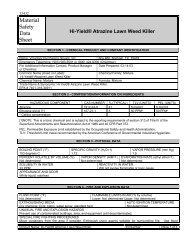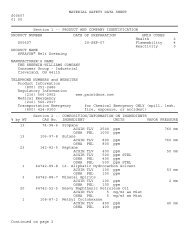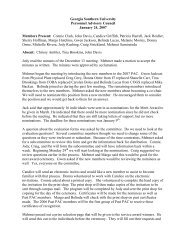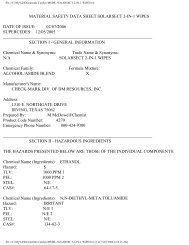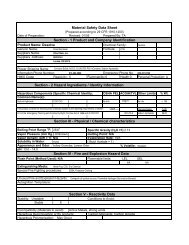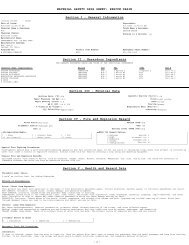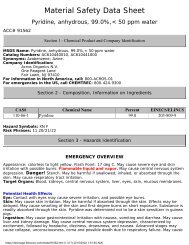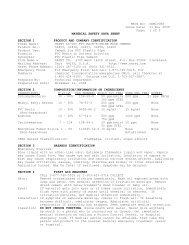MATERIAL SAFETY DATA SHEET: UNISOL PLUS ... - services
MATERIAL SAFETY DATA SHEET: UNISOL PLUS ... - services
MATERIAL SAFETY DATA SHEET: UNISOL PLUS ... - services
You also want an ePaper? Increase the reach of your titles
YUMPU automatically turns print PDFs into web optimized ePapers that Google loves.
<strong>MATERIAL</strong> <strong>SAFETY</strong> <strong>DATA</strong> <strong>SHEET</strong>: <strong>UNISOL</strong> <strong>PLUS</strong><br />
Stability<br />
Hazardous Polymerization<br />
[√] Stable<br />
[ ] Unstable<br />
[√] Will not occur<br />
[ ] May occur<br />
Conditions to Avoid:<br />
Direct sunlight and other ultraviolet sources. Avoid heat, hotsurfaces,<br />
sparks, and open flames.<br />
Conditions to Avoid:<br />
N/A<br />
Incompatibility (Materials to Avoid):<br />
Strong oxidizing agents such as Chlorine bleach, Hydrogen Peroxide, Permanganates, and Chromates. Acids and Bases; metals such as Zinc powders, Zinc,<br />
Aluminum powders, Magnesium powders, Potassium, Barium, and Sodium; Amines, Oxygen, water, Methanol, aromatic hydrocarbons, 1,1,1-Trichloroethane. Forms an<br />
explosive mixture with Nitric Acid.<br />
Hazardous Decomposition Products:<br />
Oxides of Carbon, Hydrogen Chloride, Chlorine, Phosgene, May react with freshly galvanized surfaces to produce highly toxic Dichloroacetylene.<br />
Section VIII - Spill Or Leak Procedures<br />
Steps to be Taken if Material is Released or Spilled:<br />
Wear appropriate protective clothing. Eliminate all sources of ignition and ventilate the area. Use only non-sparking equipment. Use care as spills may be<br />
slippery. Shut off source of leak. Dike and contain spill. Absorb with an inert material and transfer all material into a properly labeled container for<br />
disposal. Prevent product from contaminating soil or from entering sewage and drainage systems and bodies of water. Flush area with water.<br />
Waste Disposal Method(s):<br />
Dispose of in accordance with all Federal, state, and local regulations.<br />
Neutralizing Agent:<br />
N/A<br />
Section IX - Special Protection Information<br />
Required Ventilation:<br />
Local ventilation is recommended to control exposure from operations that can generate excessive levels of mists or vapors. Local ventilation is preferred,<br />
because it prevents dispersion into work areas by controlling it at its source.<br />
Respiratory Protection:<br />
Respirators should be selected by and used under the direction of a trained health and safety professional following requirements found in OSHA's respirator<br />
standard (29 CFR 1910.134) and ANSI's standard for respiratory protection (Z88.2-1992). For concentrations above the TLV and/or PEL but less than 10 times<br />
these limits, a NIOSH approved half-facepiece respirator equipped with appropriate chemical cartridges may be used. For concentrations greater than 10 times<br />
the TLV and/or PEL, consult the NIOSH respirator decision logic found in publication No. 87-116 or ANSI Z88.2-1992.<br />
Glove Protection:<br />
Viton or Polyvinyl Alcohol gloves should be worn. Ensure compliance with OSHA's personal protective equipment (PPE) standard for hand protection, 29 CFR<br />
1910.138.<br />
Eye Protection:<br />
Chemical goggles should be worn when handling. Ensure compliance with OSHA's Personal Protective Equipment (PPE) standard for eye and face protection, 29 CFR<br />
1910.133.<br />
Other Protection:<br />
Wear protective clothing when handling. Remove soaked clothing and shoes. A safety shower and an eyewash station should be available. Wash clothing and clean<br />
shoes before re-use.<br />
Section X - Storage and Handling Information<br />
Storage Temperature<br />
Max: 120°F Min: 35°F<br />
Storage Conditions<br />
[√] Indoors [ ] Outdoors [ ] Heated [ ] Refrigerated<br />
Precautions to be Taken in Handling and Storing:<br />
Always store material in its original container. Keep the container tightly closed when not in use. Do not store in aluminum,<br />
aluminum alloys, plastics,or zinc. Use with caution around heat, sparks, pilot lights, static electricity, and open flame. Empty<br />
containers may contain product residues which may exhibit the hazards of the product. To avoid possible explosion, do not<br />
pressurize, cut, weld, solder, drill, grind, or expose empty containers to heat, hot surfaces, sparks, or open flames. Ground and<br />
bond container when handling near flammable vapors and all sources of ignition.<br />
Other Precautions:<br />
Keep out of reach of children. Read the entire label before using the product. Follow the label directions.<br />
Section XI - Regulatory Information<br />
Chemical Name CAS Number Upper % Limit<br />
TETRACHLOROETHYLENE 127-18-4 85<br />
CARBON TETRACHLORIDE 56-23-5 1<br />
METHYLENE CHLORIDE 75-09-2 15<br />
PROPYLENE OXIDE 75-56-9 1<br />
Those Ingredients listed above are subject to the reporting requirements of 313 of Title III of the Superfund Amendments and Reauthorization Act of 1986 and 40<br />
CFR part 372.<br />
Please call 1-800-527-9919 for additional information if you are a California customer. This MSDS is not intended for users in the state of California.<br />
Section XII - References<br />
1. Threshold Limit Values for chemical substances and physical agents and biological exposure indices, ACGIH, 2007.<br />
2. OSHA PEL.<br />
3. Vendor's MSDS.<br />
4. Registry of toxic effects of chemical substances, CCINFOWeb, 2007.<br />
3 of 4



